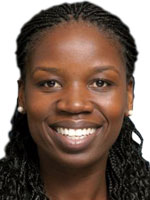Trial challenges
Some of California’s best trial lawyers lay out the preparation for and execution of your jury trial, whether it’s your first or your Fiftieth
The theme of this issue is Trial Skills. Having been in the trial trenches and experienced both wins and losses, I can appreciate the work that goes into each case and the challenges trials present. As a runner, I see trials as a 400-meter relay race. There is a series of hurdles that has to be cleared. Your trial team and experts are your team members. The verdict is the finish line. You only win if you’ve run a great race and if the jury puts your client first.
The authors in this issue have each taken on the task of addressing the challenges that trial lawyers face at trial. They offer their tips, techniques and triumphs to each of you in the hopes you will readily and gracefully clear those hurdles as you move closer to the finish line, a win for your client.
First, we look to CAALA Past President John Denove. In Gathering Evidence of General Damages, we are reminded of the importance of preparing your case for trial long before the jury is impaneled. As Denove puts it, “What general damage evidence you choose to present will be limited to the evidence you have obtained.” Without the proper evidence, obtaining a trial victory that fully addresses the harms and losses becomes increasingly more difficult. So, start early and be thorough.
Once you have started your trial, Jury Consultant Claire Plotkin will guide you through the ever-so-important, but difficult, process of selecting the ideal jury for your case. Her Do’s and Don’ts of Jury Selection are a must read. She encourages you to put your bad facts out front and face your challenges head-on.
For a different take on how to conduct voir dire, CAALA past-president Antony Stuart asks us to consider a new paradigm: Having a separate attorney conduct voir dire before you present your case. Stuart isn’t talking about a last-minute trial counsel or someone to second-chair you at your trial, but an attorney whose only part in the trial is to conduct voir dire.
In his article, Arguing General Damages in Closing, CAALA Past President Joseph Barrett offers up a step-by-step guide to talking money with jurors. Barrett provides clear examples on how to anchor the intangible losses of pain and suffering in analysis involving one’s day-to-day activities or the cost of pain management and physical therapy. Paying special attention to the art of effective communication, his article touches on both the style and substance of the damages discussion.
Greg Bentley tackles the eggshell- plaintiff doctrine in Unusually Susceptible Plaintiff and Pre-Existing Conditions. From voir dire to closing, Bentley discusses how to present pre-existing claims that resonate with the jury and increase the value of your client’s case.
For many, linking together evidence presented at trial and opinions of experts in a way jurors can understand and accept as evidence of liability is an insurmountable feat. Not for CAALA Past President Garo Mardirossian. In Expert Witness Testimony at Trial, Mardirossian examines the procedural and substantive requirements for effective presentation of liability expert testimony and offers tips on how to prep your expert for trial.
Next we look to 2017 CAALA President Ricardo Echeverria as he artfully argues for non-economic damages in trial. Echeverria offers numerous helpful tips on how to present your non-economic damages in closing argument. If you have not had the opportunity to see Echeverria deliver a closing argument, you must make it a point to do so. He is brilliant.
Jeremy Jessup is a former defense attorney turned trial lawyer for the people. Now with San Francisco-based trial firm, Dolan Law Firm, Jessup reflects on his past career. In this honest and deeply personal article, Life as a Defense Attorney and the Transformation to Representing Plaintiffs, Jessup shares with readers what prompted his change of heart (and career) and how he has grown as a result.
Finally, we hear from accomplished trial lawyer, Courtney Rowley. In a daring and authentic piece, Women at Work, Rowley puts human rights front and center as she discusses the American Bar Association’s newly enacted anti-discrimination policy. Through her own experience as a trial lawyer and mother, Rowley highlights the challenges of being a mother in the courtroom and issues a very special challenge to us all. As a sidebar to Rowley, we present a brief essay on motherhood and lawyering, Muffins with Mom, by plaintiff’s appellate lawyer Holly Boyer.
Ibiere N. Seck

Ibiere N. Seck is a Partner and Trial Lawyer at The Cochran Firm - California with a focus on complex catastrophic injury, wrongful death, traumatic brain injury, police misconduct and sexual assault of minors. She exclusively represents plaintiffs in civil litigation/trial and prides herself in being a zealous advocate on an endless pursuit for justice on behalf of people who have been wronged, harmed or injured. Since 2010, she has been recognized as a “Rising Star” by the Super Lawyers publication. She was the recipient of CAALA’s 2014 Rising Star Award, and the National Bar Association’s 2015 Nation’s Best Advocates 40 Under 40. In 2016, Ms. Seck was recognized in SuperLawyers Top 100 Up-and-Coming Attorneys in Southern California and SuperLawyers Top 50 Up-and-Coming Women Attorneys in Southern California. She was also the recipient of CAOC’s 2016 Street Fighter of the Year award. Ibiere is a board member of the Los Angeles Trial Lawyer’s Charities, Consumer Attorneys Association of Los Angeles, Consumer Attorneys of California and John M. Langston Bar Association, Los Angeles County Bar Association Litigation Section Executive Committee and Westside Children’s Center. She is also a volunteer attorney with the Mesereau Free Legal Clinic in South Central Los Angeles where she advocates on behalf of low-income Californians and under-served communities of color.
Copyright ©
2025
by the author.
For reprint permission, contact the publisher: Advocate Magazine
